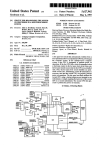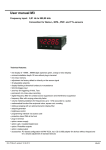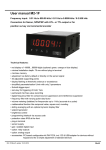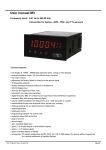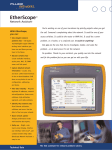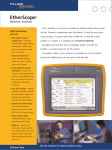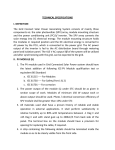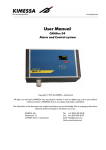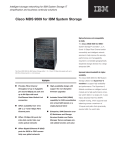Download Troubleshooting Switched Environments
Transcript
Tr o u b l e s h o o t i n g S w i t c h e d Environments Some of the issues that should be consid- Ten years ago, the network was rela- ered in a switched environment are: • How busy is each port? tively simple. There were hubs, bridges and routers. Each was a discrete box, readily identifiable from the others. Troubleshooting was also simple. If you were attached to a hub, then the rules for troubleshooting a collision domain applied. At the point where the collision domain attached to a bridge, all errors stopped. Troubleshooting using a • How do you identify and track the source of errors? • What is the source of a broadcast storm? • Are bridge forwarding tables operating correctly? • Which stations are attached to this port? • Is the switch rate-limiting any protocols or ports? • Is this port in a VLAN? And, if so, is it the same VLAN as the server or service? How do you determine where to start looking for a reported problem in a switched The entire switch tends to be part of a network? The troubleshooting difficulty orig- single broadcast domain, including any num- protocol analyzer was the best avail- inates from a basic inability to “see” inside ber of other switches connected in series or able option, and it was very effective it. This problem begins with the OSI Layer 2 in parallel. If OSI Layer 3 features are bridging performed by a switch, and is exac- enabled, then multiple broadcast domains once the user knew the basics of the erbated by enabling VLANs and other OSI are created, equal to the number of VLANs. network and the protocols in use. Layer 3 and higher features and forwarding At the extreme, and if the switch features rules. Advanced switching features such as permit it, each port could be configured to OSI Layer 4 and higher forwarding and be a separate broadcast domain. This config- load balancing require a strong knowledge uration could reasonably be described as of the switch configuration options to routed to the desktop. By creating a sepa- troubleshoot. rate broadcast domain for each port, trou- Then switches appeared on the scene. The problems found in a switched environment are generally the same as those experienced in a shared media environment. What happened, who did it, and how much? The primary difference is that answers need to relate back to a specific port. By installing a switch, you tend to create bleshooting options are limited severely. A a collision domain on each half duplex port separate broadcast domain per port will also – that is simply the nature of a switch. If need a routing service in the switch typical- shared media hubs are attached to the port, ly requiring considerable CPU resources in then the collision domain may grow to the forwarding traffic. The network situation maximum size allowed for that Ethernet where it is appropriate to require routing on implementation. Due to the falling price of every single request and reply is very diffi- switching technology, most new networks cult to imagine, and this configuration have a single station per port. So, in the should be avoided. Unfortunately, a less case of half duplex connections, the colli- obvious form of this configuration is all too sion domain is only a single cable link. Vision into Switched Networks White Paper common, and is found in networks where the servers are all located within one subnet or OptiView™ Network Analysis Solutions broadcast domain, and all users are in some have powerful troubleshooting capabili- number of other subnets or broadcast ties to put you back in control of your domains. Virtually all requests must still be switched network. routed. If maintenance activities must be Plug into the network with an OptiView limited to a single server room, then consider placing servers in separate VLANs. Then place the users that depend upon that server in the same VLAN. This configuration would allow the switch matrix to use OSI Layer 2 bridging for routine traffic, and only unusual or infrequent requests would be routed. If the server supports more than one user community, install additional network adapters in the server to maintain OSI Layer 2 connectivity to the users. Integrated (portable) or Workgroup Figure 1 – A very basic switch scenario. For simplicity, the troubleshooting model will be a server attached to a switch, as shown in Figure 1. Some descriptions will assume the user(s) in question are attached to the same switch, other descriptions will assume the user(s) in question are accessing the server through the uplink to either another switch or to a router. The troubleshooting scenario will start with a simple Analyzer and you’ll have instant vision into your switches. Trace SwitchRoute shows you the exact path two devices use to communicate through your switched network. No more hidden problems. You’ll also see: • Switch port utilization, errors and configuration • Hosts connected by port • VLANs on the switch with port membership Five techniques for troubleshooting a switch report that communications with the server There are five fundamental approaches used almost nothing. to gain visibility into a switch. Each of Method 1: Access the switch console via TELNET or the serial port full duplex, switched Gigabit Ethernet links Senior network support staff or others with working with in-line taps. OptiView the password to the switch may choose to Protocol Expert software uses extensive review the configuration of the switch dur- seven-layer decodes to make it easy to ing the troubleshooting process. The switch identify and solve tough problems on configuration is available by logging in switched segments. OptiView Console's through a TELNET session, or by attaching to SwitchTap port mirroring feature allows you the serial port of the switch and logging in. to easily and safely configure mirror ports. (Figure 2) It will even guide you to the best port to these techniques offers a different view, and has both positive and negative aspects. Like many other situations related to networking, there is no single best answer. The most suitable solution will be controlled primarily by the availability of resources (which tools are available and/or pre-installed), and by the potential service interruption that will be created by using that technique. Even combined, these techniques are not are “slow.” This report tells the support staff • Trunk ports and trunking protocol • Multiport stats show you traffic levels across switch ports at a glance. able to monitor the attached network as OptiView Link Analyzers provide real-time analysis and line rate packet capture for use with a Fluke Networks tool attached. well as when hubs – instead of switches – You can then import the mirrored data into were common. It is nearly impossible to see the OptiView Console database, trend it, all of the traffic flowing through a switch. analyze it, map it, and report on it. Most troubleshooting assumes the traffic will pass between the station and an attached Visit www.flukenetworks.com/optiview server or through the uplink. If two stations were passing information directly between Figure 2 – Using the RS-232 console port. and check out the OptiView Network Analysis Solutions. themselves, the traffic would not pass through the uplink or to any other port on the switch. Unless you knew to look for it, it probably would not be detected. Troubleshooting Switched Environments 2 The switch configuration is available from Unfortunately, the switch (which we are interrogating the broadcast domain is useful either of these console access options, viewing as a multiport bridge) will only for- for network discovery and for finding other though the configuration information will ward a very tiny amount of the traffic to the classes of problem, but will not aid a slow not reveal misbehavior on the part of the monitored port. This is appropriate behavior user connection problem significantly. switch. Whether the operating system of the on the part of a bridging device, since it’s switch has bugs, or whether the configura- designed to prevent unnecessary traffic from switches, allows traffic from a selected port tion is incomplete, is not likely to be evi- reaching ports where it does not belong. The or ports to be copied to the monitoring dent from the configuration listing. This protocol analyzer has not requested any traf- port. (See Figure 5) This technique is usual- configuration data will instead be useful in fic, and usually has not even transmitted a ly referred to as port aliasing, port mirror- guiding troubleshooting efforts to see if the single frame. ing, or port spanning. A better option, available from most The ability to copy or mirror traffic is switch is operating as expected. To validate the configuration, it will be necessary to provided by most switch vendors to allow utilize one or more of the other switch a monitoring tool to be connected to a troubleshooting methods. configured monitor port on the switch. Older switches had a specific port that A variety of runtime troubleshooting aides are available from some switches, though could be configured as this special monitor- the feature set for these troubleshooting ing port, but most newer switches can be aides is quite different depending on the configured to use any port as the output vendor and switch model. Considerable experience and theoretical knowledge is required to obtain benefit from several of these features. Method 2: Connect to a spare (unused) port The simplest approach to troubleshooting, this involves attaching a monitoring tool such as a protocol analyzer to any unused port on the switch. Figure 4 – Switches forward traffic between the source and destination port. Very little traffic goes to other ports. The monitoring tool will see a few frames per minute instead of the thousands per second that may be passing between the stations and the server port for monitoring. The implementation of this technique varies between vendors, but there are several common mirroring options. Note that in almost all cases, the forwarding technique employed by the switch will also The traffic forwarded to the monitored be used to filter data sent to the monitor port will consist almost entirely of broadcast port. This means almost all errors are fil- traffic, with a few frames resulting from tered by the switch, and do not appear on unknown destinations appearing sporadical- the monitor port. For troubleshooting pur- ly. These occasional frames are probably the poses, port mirroring can sometimes be result of aging of the bridge forwarding quite ineffective because a whole class of table, and not often from truly unknown problems is concealed by the switch in this destinations. Many unwary technicians have way. seen the traffic distribution (nearly 100 percent broadcasts) and not noticed the exceptionally low utilization level. This results in Figure 3 – Monitor from any open port. the incorrect diagnosis of a broadcast storm present, or that their network is experienc- Connecting to a spare switch port then allows the monitoring tool access to the attached broadcast domain without disrupting service anywhere. The attached tool has the same access to the broadcast domain as ing unbelievably high broadcast rates as a part of normal operation. Since this view of the network is all but useless, it is necessary for the monitoring tool to solicit traffic. Soliciting traffic or Figure 5 – Logical effect of configuring a mirror port. any other station. Troubleshooting Switched Environments 3 In addition, the actual configuration must the same time, the RX path is able to sup- between the switch port and the file server be performed either from the console (the port 100 Mbps of traffic for an aggregate allows an analyzer to be connected to the RS-232 port on the switch) or a Telnet ses- throughput potential of 200 Mbps. If you same collision domain as the file server, as sion. This often involves bringing a PC or seek to mirror that traffic to another 100 shown in Figure 7. This technique enables terminal along with the monitoring tool so Mbps port, you can only use the TX path the analyzer to see all the traffic to and that the switch can be reconfigured as from the switch to the monitoring tool. from the file server, which assists the net- required for troubleshooting. The amount of mirrored traffic is therefore work support staff in diagnosing a wide limited to a maximum of 100 Mbps. Any range of problems, including user login port, though a number of vendors permit traffic on the switch port that exceeds 50 failures, poor performance, and dropped configuring the port to be bidirectional. percent of the capacity of that link (200 connections. Configuring a mirror port on the switch Mbps) will be dropped. The mirror port is often a listen-only permits the monitoring tool to see a copy If multiple ports are mirrored to the mon- of the actual traffic between our reportedly itoring port, then this problem is potentially slow user connection and the server. The correspondingly worse. Since most switches mirrored port could be any other port on the operate at far below their capacity, the switch, including uplink ports. The mirror problem may not be noticed right away. could also be several or all other ports on Most user connections experience low single- the switch. The more ports included in the digit utilization averages. Infrequently, there mirror, the less likely the output will include is a short but large burst of traffic. Figure 7 – Using a hub to monitor a switched port. This approach is impractical in most situations, particularly where there are multiple all of the traffic, and the capacity of the servers to be monitored. Where do you output port is rapidly exceeded. locate the hub? On all shared resources? If you choose to move a hub around as Output capacity on the monitoring port is an important problem. The output port has a needed, are you prepared to interrupt the TX and RX path. It was already noted that network long enough to install the hub? the TX path from the monitoring device back to the switch may be blocked by the switch Figure 6 – Output capacity is limited on a mirror port. This delay is often long enough to cause dropped connections. Additionally, shared as part of the mirror configuration. Whether The situation may be mitigated by resources may be connected via a technolo- or not the TX path is blocked (whether the connecting the monitoring device to a gy or connection speed that your monitoring port is bidirectional or not) the RX path higher speed port, one which has the tool may not support. from the switch to the monitoring device is native capacity to accept all of the mirrored capacity limited. If you are mirroring a full output. If the mirror output port in Figure 6 tive way to monitor all traffic and errors duplex port of the same speed as the mirror were a Gigabit port instead of a 100 Mbps present on a link. This is nearly the only output port, the switch may easily drop traf- port, then the aggregate 200 Mbps traffic way to actually see and analyze MAC Layer fic without notifying you. In this regard, it load would be easily accommodated. errors in a switched environment. Using does not matter whether the monitoring device is connected at half or full duplex; the inherent limit to the output path is the same. Assume you are seeking to monitor the traffic associated with a server connected to the switch at 100 Mbps in full duplex. At full duplex, the server’s port – the TX path – Method 3: Insert a hub into the link Using a shared media hub involves a strategic placement of the monitoring tool. In many networks, most traffic will be received or transmitted by a shared resource such as a file server. Adding a shared-media hub Using a shared media hub is still an effec- SNMP to learn about them is useful. But, for good error analysis, there is nothing like seeing them with the diagnostic tool directly. There are two major drawbacks to this method. The server link cannot be a full duplex connection or the resulting duplex mismatch will introduce more errors than is able to support 100 Mbps of traffic. At Troubleshooting Switched Environments 4 you are likely to reveal. Also, to diagnose path will be offered on one connection and problems with this method, a shared media the receive path on another. hub is necessary. Many newer hubs are actu- To simultaneously monitor a request and ally bridging devices masquerading as hubs. response passing through the tapped link, it If you insert a hub that is not a shared is necessary to have a monitoring tool with media device, then you will not see the traffic you are looking for. It would be the equivalent of inserting another switch in the link, and would not benefit you at all. Dual speed hubs – such as 10/100 – may offer a collision domain at each speed, with a bridge between speeds. In this situation, you can use the dual speed hub as long as you are certain the monitored link is operating at the same speed as the diagnostic tool. Other hubs offer full bridging between all ports, and are therefore actually misleadingly labeled low-cost switches. They will not work for this method. two input ports. Tools with dual inputs Figure 8 – Use of a tap or splitter fiber link. Some transmitters are more robust than others, so even if installation of a splitter at one end causes the link to fail, it may still be possible to install the splitter at the other end of the link without causing it to fail. Fiber optic splitters do not require power, as the split is accomplished by splicing fiber optic strands together very precisely. Since the splice is created in alignment with the inbound signal, it is vital to ensure the splitter input and output lems, as some of the signal is needed by the This is somewhat similar to adding a shared tap in order to read the passing traffic. For media hub, except the tapped link may only copper cables, this is the equivalent of addi- be used for receiving and does not allow the tional attenuation, and also may cause the monitoring tool to transmit. tapped link to fail during the installation for analysis. The alternative is to examine traffic in one direction at a time, which is more difficult to analyze. There is no operational difference when monitoring half duplex or full duplex, and a tap is equally effective with either. You have the choice of monitoring a single direction separately with a typical single-input monitoring tool, or monitoring both directions simultaneously with a dual-input monitoring tool. Copper taps cause similar signal loss prob- Figure 9 – Functional diagram of tap operation process if the link being tapped is very long interchangeable, though splitter usually or is already facing cable problems. Copper applies to fiber optic links. On a fiber optic taps require power, as the signal is recov- link, the splitter is rated by how much light ered and retransmitted to the monitor port. is taken from the primary path and redi- If properly designed, a copper tap will not rected to the monitoring path. Typical drop or disrupt the tapped link if power is splitter ratings include 80:20, 70:30, or lost to the tap. even 50:50. Using the first example, 80 per- direction, or to integrate both data streams cables are connected correctly. Method 4: Using a tap or splitter The terms tap and splitter are potentially typically have the ability to separate each Tapping the line is an excellent way to cent of the light continues through the see what is passing through a link. Once splitter to its original destination, and 20 installed, the tap is invisible to the attached percent of the light is redirected to the devices and may be utilized at any time monitoring connection. This loss of power without further disruption. Unfortunately, clearly implies that if a link is already suf- the link must be broken to insert the tap. fering from cable faults or excessive dis- Furthermore, the nature of a tap or splitter tance, the splitter could easily cause the is that it will offer the data passing in each link to fail by taking too much light from direction separately. That is, the transmit the primary transmit path. A splitter can easily cause a 3 dB loss in power over a Troubleshooting Switched Environments 5 Method 5: Query the switch using SNMP unrestricted, then potentially anyone Almost the only effective method of on your network or modifying your switch troubleshooting a switched network is to configurations. SNMP is usually enabled with ask the switch itself how the network is a very common password when the switch is behaving. This is done with SNMP or by sold. SNMP passwords are called community connecting to the console port of the switch. Obviously, directing queries through anywhere could be monitoring activity Figure 10 – Using SNMP to monitor a switch. Because switches do not routinely forward the console port is not desirable because errors, using SNMP is perhaps the best you would have to physically touch every method of locating ports experiencing them. switch in the network. It is possible to The switch may not forward the error, but it minimize the impact of this alternative by is certainly aware of the presence of errors. setting up terminal servers that connect to There are a variety of MIBs available from the console ports. SNMP is a better choice most switches that support SNMP. Each MIB most of the time because it allows you to supported brings the console a slightly dif- make queries in-band from anywhere on the ferent or more detailed view of network con- attached network, and it does that without ditions around the switch. In addition to any extra hardware. If you have implement- private MIBs, which typically have cus- ed a network management system, you may tomized support for each switch and level of configure the switch to send an unsolicited operating code, the standard MIBs can be response called an SNMP trap whenever uti- used very effectively to monitor a switched lization, errors, or some other parameter network. In increasing order of detail, the exceeds a specified threshold. Then use net- following MIBs are useful for troubleshoot- work management or a network monitoring ing, though many others are good too. tool to investigate what caused the thresh- RFC 1213 – MIB II old to be exceeded. RFC 1643 – Ethernet-Like Interface MIB Virtually all but the least expensive RFC 2819 – RMON Ethernet switches ship with SNMP management capa- RFC 2021 – RMON 2 bility. The primary differences are in how RFC 2613 – SMON granular the answers are. Some less expen- Many RFCs are updated or enhanced follow- sive switches have SNMP agents that only ing their introduction, so always check the offer information about the switch as a latest RFC index for updates. For example, whole; other, more expensive switches offer RFC 1213 is updated or enhanced by at least very detailed information about each indi- five newer RFCs (2011, 2012, 2013, 2358 vidual port. and 2665). In addition to the MIBs defined SNMP is probably the most common and by these RFCs, which contain excellent infor- least intrusive method of monitoring a mation on utilization and errors, the bridge switched network. The SNMP console does MIB (RFC 1493) is very useful for trou- not have to be anywhere near the monitored bleshooting. device as long as there is a routed path to Security is a concern when using SNMP the target, and security configurations per- to monitor a network. If SNMP agents are strings, and are both case and punctuation sensitive. Community strings are transmitted in clear text, too, which in itself creates a security risk. While not widely deployed at this time, SNMP V3 offers encrypted communication to address this exposure. The most common default community string is public. It is shocking how many SNMP agents are accessible from the Internet with the public community string – even today. At a minimum, the default community string should always be changed immediately. Agents may be configured to respond to different community strings for different levels of access, to queries from a specific subnet and no other, to queries from a specific IP address and no other, and many other configurations. The routers providing a path to those SNMP agents may impose a variety of limits on SNMP. Firewalls may block SNMP entirely. If you are able to reach the agent using SNMP, the agent still has to support the MIB you are querying. Most vendors support the standard MIBs adequately. However, some vendors do not. In some cases it is necessary to upgrade the operating system on the switch before it is capable of supporting a desired MIB. Problems with this method include when an SNMP agent’s implementation of a specific MIB is not accurate, and responses to queries are simply wrong. It doesn’t happen that often, but programming errors occasionally result in inaccurate responses. mit the console to communicate with the agent in the switch. Troubleshooting Switched Environments 6 There are many reasons why your switch does not respond to a specific SNMP query. Once any access problems are resolved, SNMP offers a very useful tool for monitoring and trending. Conclusion A commonly used troubleshooting method is to wait for user complaints. This method should not be discounted due to its simplicity – it is very effective. The user community has a very finely tuned subconscious sense of what the normal performance of the network is. Any perceived degradation of that sense of normal will result in a rapid complaint to the network support center. Once a user complains, you can start the troubleshooting process from his or her connection point. The problem with this method is that it is entirely reactive instead of proactive. Ideally, the approach should be proactive. Proactive efforts to prevent problems from affecting users include regularly interrogating each switch, and monitoring the quality of traffic on each switch port – just as any other segment would be monitored on a regular basis. Implementing tactics such as monitoring and trending switch port statistics and using tools that allow you see inside switches will take you from a troubleshooting mode to a trouble prevention mode. N E T W O R K S U P E R V I S I O N Fluke Networks P.O. Box 777, Everett, WA USA 98206-0777 Fluke Networks operates in more than 50 countries worldwide. To find your local office contact details, go to www.flukenetworks.com/contact. ©2004 Fluke Corporation. All rights reserved. Printed in U.S.A. 4/2004 2142429 A-ENG-N Rev A







